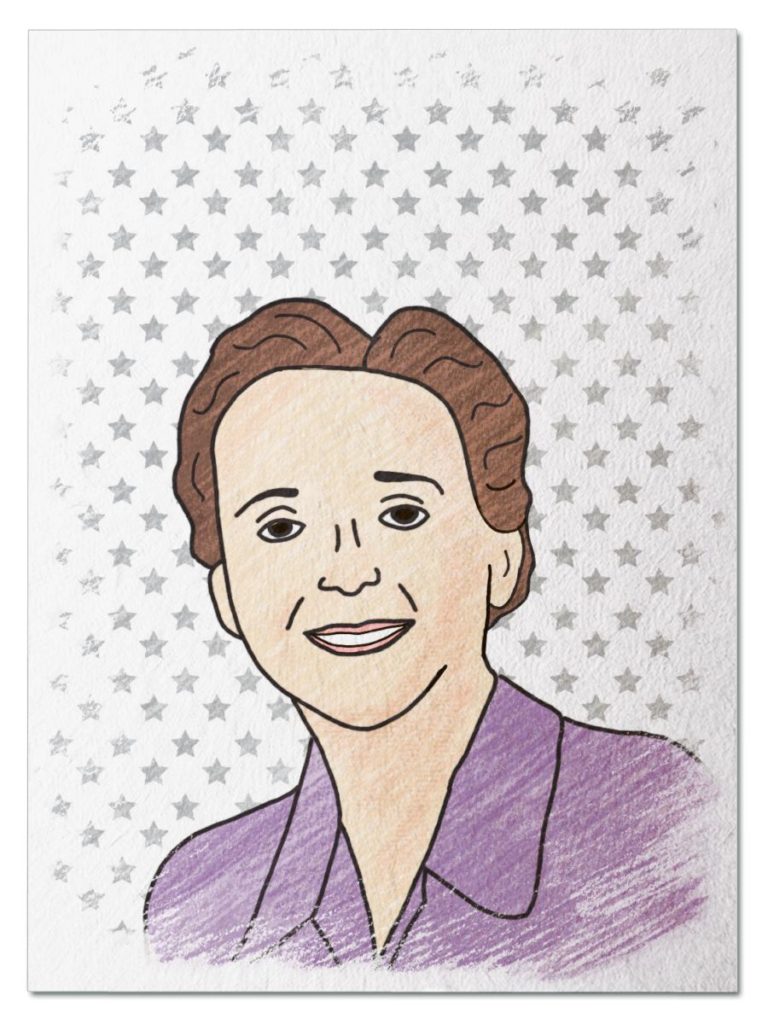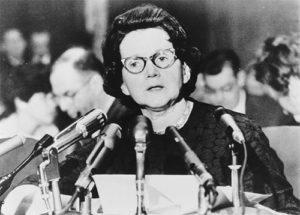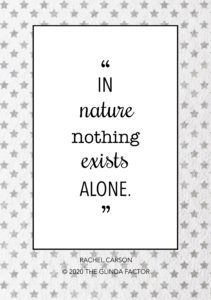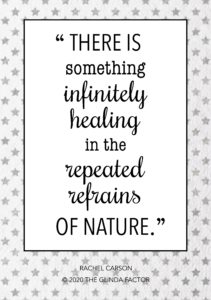
Super Scientist
When she published her book, “Silent Spring,” she had no idea that she would inspire so many people with her gift for explaining complicated concepts in an accessible and fascinating way. Her description of the web of life that surrounds us and the impact of human actions grabbed the attention of the nation. It became a best seller and proved that one book can change the world. Head back to 1963 and meet “the Mother of the Modern Environmental Movement,” Rachel Carson…
Her Ruby Shoe Moment
The Power of the Wand
Her Yellow Brick Road
Brains, Heart & Courage
Glinda’s Gallery
Just the Facts
Her Ruby Shoe Moment
On June 4, 1963, Rachel Carson sat before five Congressmen in Room 102 of the New Senate Office Building. It was a small, windowless room and packed with reporters. If Rachel was nervous, she didn’t let it show. She folded her hands, adjusted her notecards, and tested the microphone before beginning her statement:
“Mr. Chairman, I appreciate the opportunity to discuss with you this morning the problems of environmental hazards and the control of pesticides”
Rachel went on to testify before a subcommittee of Congress about the environmental impact of pesticides (DDT in particular). She talked about the damage to water, air, soil, animals, plants, and humans that is caused by wide-spread use of pesticides.

Smithsonian Institution
But Rachel didn’t advocate for a total ban on pesticides. Instead, she asked the government to think critically about new technologies and balance the expected benefits against the potential side effects. Ultimately, she wanted the safety of chemicals to be rigorously tested before being used. And she wanted chemicals contained in household products to be clearly labeled, so people understood the risk of use in their homes.
Rachel testified for 90 minutes. And it left her completely exhausted. She didn’t have much energy to begin with — she was battling breast cancer and no one knew about it. Rachel worried that people would assume she had an ulterior motive if they knew her condition. And the chemical companies could use it against her. So she kept it a secret.
Rachel was invited to speak before the Congressional subcommittee because of her book, Silent Spring, which was published in 1962. In the book, she told a story about the web of life that surrounds us and described the impact of human action on nature. She highlighted real life examples to explain her scientific points. Ultimately, she called pesticides “the elixir of death” — indiscriminately killing everything in its wake (plants, animals, insects). And she blamed the wide-spread use of pesticides for upsetting the “balance of nature.”
 Silent Spring was a huge success. Over 40,000 copies were pre-sold before it was released. It was on the New York Times bestseller list for 86 weeks (over 1 1/2 years!) and resonated with a lot of Americans — people from all over the country shared their stories and called their representatives.
Silent Spring was a huge success. Over 40,000 copies were pre-sold before it was released. It was on the New York Times bestseller list for 86 weeks (over 1 1/2 years!) and resonated with a lot of Americans — people from all over the country shared their stories and called their representatives.
Rachel’s book also caught to the attention of President John F. Kennedy. So he ordered his Scientific Advisory Committee to investigate the long-range side effects of DDT and other pesticides. It’s report confirmed Rachel’s conclusions in Silent Spring. Before long, states across America introduced bills to govern the use of pesticides.
The Power of the Wand
Through Silent Spring, Rachel introduced the idea that human actions impact the environment around us. Rachel brought national attention to the conservation of natural resources and led to a nation-wide ban on the chemical, DDT. And she helped to launch the environmental movement — in fact, some people call her the “Mother of the Modern Environmental Movement.”
Rachel’s work paved the way for future generations of environmental activists, such as Greta Thurnberg. Greta began her activism career at age 15, when she protested against climate change in front of the Swedish parliament building — before long, millions of students around the world joined her school strike (its called Fridays for Future). And Greta didn’t stop there. In 2019, she addressed the U.N. Climate Action Summit and was named Person of the Year by Time magazine. She was even awarded the Rachel Carson Prize!
Her Yellow Brick Road
It took Rachel over two years to research and write Silent Spring. But she had been thinking about the ideas in the book for much longer. While working for the federal government, she saw the effects of chemicals on marine life firsthand. Then, she noticed a decline of birds in areas where pesticides were used. The more she learned about the effects of chemicals on the environment, the more concerned she became.
 DDT was originally used by the military to stop the spread of typhus during World War War II (it killed the lice that spread the disease). After that, chemicals seemed to be the solution for every problem in America. People across the nation used it to control pests on their farms and in their gardens. And the government began to use DDT on a large scale — it was sprayed across America to kill insects such as the gypsy moth and fire ant. The problem, however, was that DDT killed everything in its path, not just the target insects. Rachel collected all the evidence she could find of DDT’s damage to nature.
DDT was originally used by the military to stop the spread of typhus during World War War II (it killed the lice that spread the disease). After that, chemicals seemed to be the solution for every problem in America. People across the nation used it to control pests on their farms and in their gardens. And the government began to use DDT on a large scale — it was sprayed across America to kill insects such as the gypsy moth and fire ant. The problem, however, was that DDT killed everything in its path, not just the target insects. Rachel collected all the evidence she could find of DDT’s damage to nature.
Rachel expected a lot of controversy around her book. And she was right. Silent Spring infuriated both the agricultural and chemical industries in America. Some companies tried to discredit both Rachel and her work. In particular, DuPont Chemical Company (one of the biggest manufacturers of DDT) attacked Silent Spring — they hired people to inspect every line of the book for inaccuracies; they tried to suppress press coverage by threatening to pull advertising revenue; and they released negative book reviews.
But it didn’t work. Rachel’s documentation was airtight and she had been meticulous in her fact-checking. Even more, she had the support of the scientific community. Before publication, Rachel had asked scientists to independently verify the information in each chapter. The scientists reviewed her research and supported her claims.
Brains, Heart & Courage
Rachel grew up in Springdale, Pennsylvania, just outside Pittsburgh along the Allegheny River. She spent hours exploring the woods and creeks surrounding her home. As a result of her childhood experiences, she developed a deep love for nature.
At an early age, Rachel knew she wanted to become a writer. In fact, she wrote her first story at age 8. Then, she entered a writing contest when she was 10 years old — her essay won second place and was published in St. Nicholas magazine.
 After high school, Rachel attended the Pennsylvania College for Woman and intended to major in English literature. But then, she took a biology class and fell in love with science. After earning her master’s degree in zoology, Rachel got a job with the federal government that combined her two loves — writing and science.
After high school, Rachel attended the Pennsylvania College for Woman and intended to major in English literature. But then, she took a biology class and fell in love with science. After earning her master’s degree in zoology, Rachel got a job with the federal government that combined her two loves — writing and science.
Rachel supplemented her federal income by doing some freelance writing for newspapers and journals. One of her articles got the attention of publishers — she had a talent for describing complex ideas in a clear manner. Her work read like fiction, but was also scientifically accurate.
Rachel went on to publish a trilogy about the ocean. Her first book, Under the Sea Wind, was published in 1941. It was a story of the various sea creatures that lived in the oceans. Her second book, The Sea Around Us, described the relationship between sea and land. Her last book about the ocean, The Edge of the Sea, focused on the ecology of the Atlantic seashore.
The royalties from Rachel’s trilogy of the ocean gave her financial independence for the first time in her life. It allowed her to retire from her government job to focus on her writing career. It also gave her the luxury to pick projects she was passionate about. And Rachel went on to change the world with Silent Spring.
Glinda’s Gallery
Visit Rachel’s digital scrapbook on Pinterest: https://www.pinterest.com/theglindafactor/rachel-carson/
Just the Facts
- Rachel was born on May 27, 1907 as the youngest of three children.
- Rachel graduated from Pennsylvania College for Women (now Chatham University) in 1929 with a biology degree. Then, she earned a master’s degree in zoology from Johns Hopkins University in 1932.
- After Rachel’s father died in 1935, she became financially responsible for her family. So she invited her mother, sister and niece to live with her in Baltimore. Her mother took care of responsibilities at home and served as her assistant.
- In 1936, Rachel was hired to draft educational material, brochures and radio show scripts for the US Bureau of Fisheries (now the Fish and Wildlife Service). In fact, she was one of the first women to be employed full time by the Bureau. Rachel worked for the federal government for about 20 years, rising through the ranks and eventually being promoted to Chief Editor of Publications.
- In 1951, Rachel spent a summer in Maine and fell in love with the area. After she achieved financial success, she bought some land there and built a cabin. For the rest of her life, Rachel split her time between her homes in Maine and Maryland.
- Rachel earned the Guggenheim Fellowship for Natural Sciences in 1951.
- The Sea Around Us was on the New York Times bestseller list for over one year, received the National Book Award for Nonfiction and numerous other awards, and was translated into 30 languages.
- Rachel was on the Board of Directors of the Audubon Society for many years.
- Rachel suffered a number of health problems over the years. For example, she was hospitalized for an ulcer, pneumonia and a sinus infection. Then, she developed breast cancer. She was extremely private, however, and went to great lengths to hide her illness. Many of her colleagues didn’t know she suffered from cancer until the day she died.
- Rachel died from breast cancer on April 14, 1964 (she was 56 years old). She donated her papers to the. She also bequeathed part of her estate to the Nature Conservancy and Sierra Club.
- President Jimmy Carter awarded Rachel the Presidential Medal of Freedom posthumously in 1980. She was also included on Time Magazine’s list of the 100 most important people of the 21st century.
Want to Know More?
Carson, Rachel. Silent Spring. New York: Houghton Mifflin, 1962 (Anniversary edition released in 2002).
Lear, Linda. Rachel Carson. New York: Henry Holt & Company, 1997.
Rachel Carson Congressional Testimony, June 4, 1963 (http://michiganintheworld.history.lsa.umich.edu/environmentalism/items/show/472).
H.R. Res. 450 of 110th Congress, Resolution Recognizing Rachel Carson (https://www.congress.gov/bill/110th-congress/house-resolution/450/text).
President’s Science Advisory Committee: Pesticides Report, May 15, 1963.
The Life and Legacy of Rachel Carson (rachelcarson.org)
